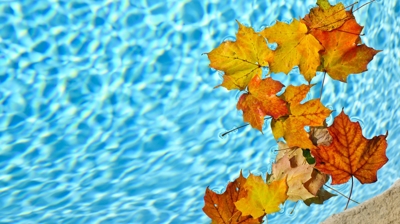- Thomas Pools
- Pool options ,
- September 29, 2025
Choosing the right material for your pool is a big decision for any Southern California homeowner. Our unique climate, soil, and active lifestyle mean your pool material affects not just how your backyard looks, but also maintenance, durability, and long-term value. At Thomas Pools, we have seen firsthand how the ideal pool material can transform your experience, whether you love hosting family barbecues or simply relaxing in the sun. Let’s take an in-depth look at how your choice of pool materials in Southern California shapes every aspect of outdoor living, and what you should consider for the long haul.
What Makes Pool Materials Perform Differently in Southern California?
Southern California’s combination of intense sun, seasonal droughts, strong UV rays, and periodic earthquakes sets the region apart from the rest of the country. Each factor impacts how pool materials age and how much maintenance they require. UV exposure can fade colors and degrade surfaces faster than in cooler climates, making longevity and appearance two major concerns. The wide temperature swings between day and night also cause certain materials to expand and contract, increasing the risk of surface cracks or warping over time.
Soil conditions vary across Los Angeles, Ventura County, and Santa Clarita. Sandy soils shift easily, while clay can swell and shrink as moisture levels change. These conditions apply extra pressure on pool shells and foundations, so it’s crucial to select a material that can adapt to movement without significant damage. Soil tests and a professional site assessment help prevent costly surprises and make sure your investment stands up to these regional challenges.
Finally, the local water supply presents its own maintenance hurdles for pool owners. Higher mineral content and “hard water” contribute to scaling and staining on pool surfaces, demanding more frequent cleaning and treatments. Pair that with water-use restrictions that are common in the area, and it’s clear that selecting a pool material with water conservation in mind is no longer just a preference—it’s a necessity for many homeowners.
How Do Concrete, Fiberglass & Vinyl Pools Compare for Southern California Weather & Usage?
Concrete pools stand out for their design flexibility and lasting strength, making them a popular choice for homeowners seeking a truly custom backyard retreat. In Southern California, a well-built concrete pool holds up well to lengthy swim seasons and frequent use. However, our region’s earthquakes and soil shifts can sometimes trigger hairline cracks or surface blemishes. Enhanced construction techniques like reinforced shotcrete and steel rebar allow us to offset many of these issues and maximize the lifespan of concrete pools, even under challenging conditions.
Fiberglass pools are gaining ground thanks to their smooth, nonporous surfaces that resist algae and reduce cleaning time. The material is flexible enough to absorb some ground movement, making it a reliable option in neighborhoods prone to minor quakes or soil shifts. However, fiberglass pools are pre-molded, which means size and shape options are limited compared to concrete. If you have a specific vision or an uncommon backyard layout, discussing your preferences with a builder is essential to avoid disappointment later on.
Vinyl pools appeal to homeowners who want a fast, cost-effective installation. The soft liner offers comfort underfoot and a gentle feel for families with kids. Still, vinyl is vulnerable to punctures from tree branches, pets, or vigorous activity. High UV exposure in Southern California can especially shorten a liner’s lifespan unless you select an upgraded, UV-resistant product. We always discuss the best liner options for the local climate to help you avoid premature replacements and unexpected costs.
Which Pool Material Is Most Cost-Effective in This Region?
While upfront installation costs matter, we recommend everyone look at the full 10-year cost of pool ownership before making a decision. For concrete pools, expect higher initial investments due to the site-specific design, custom rebar, and tailored finishing options. Over the first decade, you’ll need to resurface or re-plaster the pool, manage higher chemical use, and plan for occasional repairs—adding to long-term ownership costs.
Fiberglass pools typically land in the middle of the upfront cost scale. With their slick, easy-to-clean finish, you save money on maintenance, chemicals, and cleaning tools. Major shell repairs are rare, but when needed, they can require specialized labor and materials. Routine maintenance, balanced water chemistry, and professional installation all help keep total costs manageable over time. This option remains attractive for homeowners who want minimal upkeep and stable operating expenses.
Vinyl pools have the lowest initial price, but their true cost becomes clear after several years of use. You should plan for liner replacements every five to nine years, with higher exposure to sunlight and wear shortening that window. Over a decade or more, the cumulative expense for new liners, minor repairs, and extra water to refill after each replacement adds up. Smart budgeting means looking beyond initial installation and considering how ongoing repairs or frequent replacements will affect your long-term finances.
What Maintenance Challenges Are Unique to Each Pool Material in Southern California?
Maintenance needs vary by material, and our dry, sunny climate amplifies certain challenges. Concrete pools require regular brushing to protect against algae, especially as the plaster surface ages. The harder the water, the greater your struggle against calcium buildup, stains, and rough spots. When unmanaged, these issues can speed up the need for costly resurfacing. A robust maintenance routine—paired with professionals who understand local water chemistry—helps concrete pool owners avoid bigger problems down the line.
With fiberglass pools, the biggest appeal is reduced upkeep. Their nonporous finish limits algae and mineral buildup, making cleaning efficient and cost-effective. However, it’s important to stay on top of water balance. Wide swings in pH and chemical levels can cloud or fade the gelcoat, making restoration time-consuming. During droughts or heat waves, letting water levels drop too much creates additional risks, such as pool shifting, so prompt, informed attention is key.
Vinyl pool owners must be vigilant to prevent tears, fading, and chemical damage. Regularly checking the liner for small holes is essential, since these can become costly leaks. Avoid abrasive cleaning tools and chemical shocks that can shorten liner life. Investing in a thicker, UV-treated liner and a schedule of gentle cleaning goes a long way toward maximizing usability, even with frequent use and direct sun exposure.
How Do Pool Materials Affect Water Usage & Eco-Friendliness?
Water conservation is essential in Southern California, where droughts are frequent and restrictions are common. Fiberglass pools rank high in water efficiency due to tight, seamless shells that minimize evaporation and leakage. Their smooth finish helps circulate water more effectively, which means less backwashing and smaller water changes throughout the year. Over time, many homeowners notice a difference in utility bills, especially when paired with a high-quality cover or efficient pump system.
Concrete pools, with proper sealing, can be water-wise as well, but cracks or worn plaster increase the risk of leaks. Keeping surfaces in good shape is crucial for both eco-friendliness and maintaining stable water levels. While larger pool footprints can mean more initial water is required, regular care and the addition of modern water-saving features support responsible usage.
Vinyl pools can conserve water if the liner remains fully intact. Unfortunately, unnoticed seam or wall leaks sometimes cause ongoing water loss and a spike in usage. Newer liners often feature more durable seams and improved environmental standards, but not all can be easily recycled at end of life. Homeowners can improve their pool’s sustainability by using pool covers, maintaining liners, and scheduling timely repairs whenever issues arise.
Does Pool Material Choice Impact Resale Value in Southern California?
Whether you plan to move soon or stay for decades, your choice of pool material can influence how buyers see your property. Concrete pools typically deliver the greatest long-term value, especially when they reflect custom design and are kept in good repair. These pools are often seen as upgrades among buyers in luxury markets or neighborhoods where high-end homes dominate. The broad design choices and durability make concrete especially appealing among discerning buyers who want a standout backyard.
Fiberglass pools have real appeal for buyers looking for convenience and lower upkeep. Their reputation for easy care and stable operating costs frequently attract busy families, retirees, and those wanting turnkey properties. In competitive real estate markets, a modern, well-maintained fiberglass pool may offer as much appeal as a concrete option, particularly when buyers aren’t focused on custom shapes.
Vinyl pools can impact property value differently. If the liner is new and looks well cared for, vinyl can still boost curb appeal. However, an aged or dull liner can serve as a red flag, prompting buyers to request repairs or concessions. The value of any material increases with proactive maintenance records, recent upgrades, and transparent care. Keeping documentation on liner replacements or shell repairs is a smart move if resale is on your horizon.
How Do Pool Materials Influence Custom Features & Luxury Upgrades?
If you dream of stunning custom features or luxury elements, your pool material determines what’s possible and how much freedom you’ll have. Concrete pools open the door to one-of-a-kind designs—think vanishing edges, intricate mosaics, multi-level tanning shelves, or integrated spas. For homeowners seeking a statement pool to set their property apart, concrete stands out as the most versatile canvas. This flexibility allows for creative solutions, even on challenging sites or with complex property lines.
Fiberglass pools have improved significantly, now offering built-in tanning ledges, benches, and thoughtful safety features. These features are defined by the manufacturer’s mold and are installed as integral parts of the pool shell. Many homeowners enjoy a sophisticated look with minimal maintenance, as features blend seamlessly into the finished pool. Still, if your vision extends to dramatic curves or extra-deep designs, the choice of molds will define your limits.
Vinyl pools permit options like gentle entry steps, small tanning ledges, and personalized liner patterns. Adding larger or more technical features is possible but may significantly increase overall project complexity and cost. This material works best for straightforward backyard designs or when you value variety in liner graphics as a form of customization. Reviewing local trends and your priorities with professionals helps clarify what is both feasible and stylish
Call Thomas Pools now at (661) 495-9030 or send us a message online.

